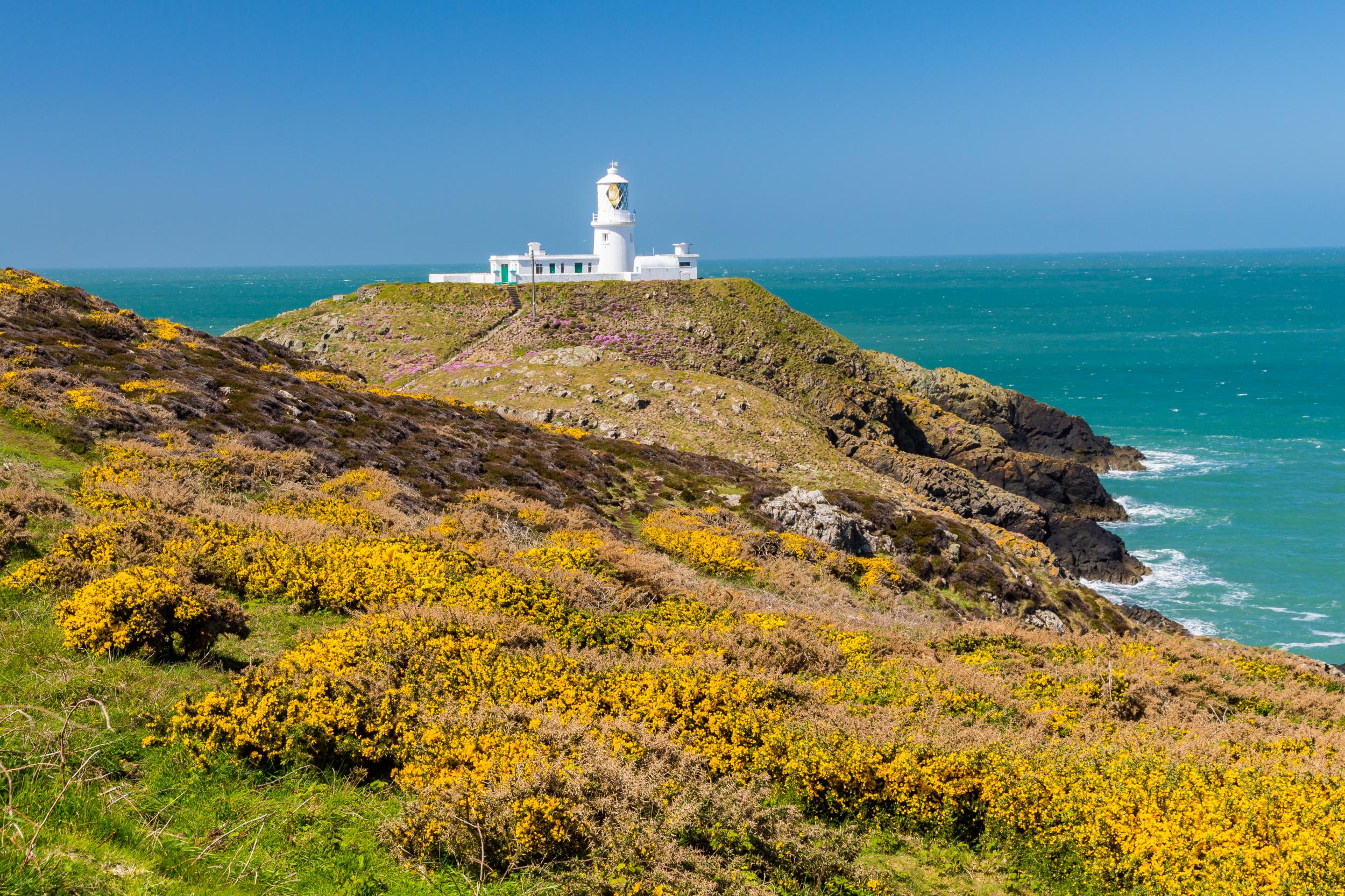Few places can be more life-enhancing in spring than Strumble Head. This huge rocky, raised outcrop pushes north from the Pembrokeshire coast into the sea. As it does so, it acts as a kind of geological butterfly net, catching and halting the progress of some dramatic birds that are on their way north to breed. Arctic skuas, typically associated with Orkney and Shetland, are regularly seen here in May, as are sooty shearwaters, birds that spend our winters on the impossibly remote southern south Atlantic Ocean island of Tristan da Cunha. Manx shearwaters, meanwhile, breed along the coast in large numbers.
Their presence brings a touch of elemental exoticism to these parts, as well as instances of nature red in tooth and claw, for the skuas will sometimes take on mild-mannered puffins, shaking them until they drop their catch, or if they are feeling bold, even attack ducks twice their size. Their even larger and more aggressive cousin, the great skua, has been spotted here tugging at the wing tips of gannets to make them drop their catch..
Strumble Head is far from the lonely fiefdom of the hard-core twitcher and there is plenty aside from avian thuggery to keep walkers busy. The promontory is watched over by a dramatically perched lighthouse and is one of the best places in Europe to see harbour porpoises, while bottle-nosed dolphins, grey seals and even orcas can be spotted from the observation hide. Come here towards the end of summer and in calm seas you have every chance of seeing sunfish, almost four metres in diameter, cutting through the waters. Basking sharks are an added bonus.
Before setting out on this walk you can enjoy all this activity from the relative shelter of the sturdy whitewashed Second World War lookout that has evolved into one of Europe’s most important wildlife watching observatories. The centre was officially opened in 1988 by Bill Oddie, though apart from a few information posters, it appears to have changed little since its wartime days.
The path winds south-east from Strumble Head, taking time to descend its flanks to become a bracing, classic cliff-top walk. Far ahead, the other side of Fishguard, is the solid lump of Dinas, another headland that hides much of the coast further east. A solitary chough, with its dashing red beak, lurches out of the cliff top edges and floats away on the strengthening breeze.
The coves are sometimes narrow, sometimes broad, all are smothered at their summits in gorse the colour of acid yellow. The landscape around Y Globa Fawr gets even more rugged and here the cliffs are a harsh grey and caves have been hollowed out at their base. Even so, the ups and downs merge into one another and it can be useful to turn to the grid references that have been thoughtfully etched into the many footbridges along the way. Far below, we occasionally spot sure-footed fishermen balanced on rocks in pursuit of pollock.
Just beyond Carn Halen we spot what at first glance appears to be an ancient monolith standing isolated at the headland overlooking Carregwastad Point. The weathered wording is hard to decipher but unexpectedly marks the place where in 1797 Britain was last invaded. During the Napoleonic Wars the French launched a substantial if chaotic landing on Welsh soil with a drunken force of 1,200 soldiers – mainly Frenchmen and convicts – led by an elderly American. Their hope was that the common man of England and Wales would join in solidarity with their Gallic counterparts. They got as far as taking over Trehowel farm a mile inland but the invasion quickly foundered: the Welsh peasantry remained unmoved and the Pembroke Yeomanry quickly overcame the disorganised rabble.
From the memorial stone we drop down to a narrow wooded valley. It’s an enchanting place; there are swings attached to the boughs of the sycamores and birches and the clearings around the stream suggest people lived here for some time right up to Victorian times.
We turn inland to reach the hamlet of Llanwnda and the lonely church of St Gwyndaf. The bell-tower leans alarmingly away from the roof, adding to a sense of remote abandonment. The French invaders made it as far as the church, broke in and stole the silver, though it did them little good.
The redoubtable Strumble Shuttle bus runs through Llwanda but the weather is good and we return inland, a quick journey along quiet lanes. The drama of the coast remains in close proximity but is for the most part hidden from view. Instead, the walk is characterised by chirruping song and of birds hastening back and forth, beaks full of worms and insects. It’s spring and the avian invasion is proving more enduring than that of the French.
Travel Essentials
START/FINISH: Strumble head car park;
DISTANCE: Four miles/ 7km to Llandwnda; six miles/ 10km if return inland to Strumble Head
TIME: 2.5-3.5hours
OS MAP: OL 35 North Pembrokeshire
Directions: Follow the coast path east from Strumble Head car park. Just beyond the memorial stone to the French invasion the path drops down to a stream and woodland. Follow the path uphill for 50m and turn right following fingerpost sign across fields to Llanwnda church. From Llanwnda pick up the track that heads west to Trennewydd and follow lanes back to Strumble Head
Transport: The closest train station is Fishguard Harbour, served by Arriva Trains Wales (08457 484950; nationalrail.co.uk) from Swansea, Cardiff and Newport. The Strumble Shuttle runs to Strumble Head from both Fishguard and St Davids (pembrokeshire.gov.uk).
Accommodation: Mark Rowe stayed at Glandwr Farmhouse at Newport, Pembrokeshire (01437 721674; experience-mor.org), which costs from £975 per week.
More information: visitpembrokeshire.com
Subscribe to Independent Premium to bookmark this article
Want to bookmark your favourite articles and stories to read or reference later? Start your Independent Premium subscription today.


Join our commenting forum
Join thought-provoking conversations, follow other Independent readers and see their replies